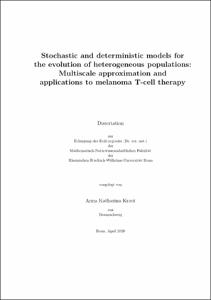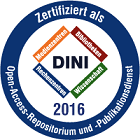Kraut, Anna Katharina: Stochastic and deterministic models for the evolution of heterogeneous populations: Multiscale approximation and applications to melanoma T-cell therapy. - Bonn, 2020. - Dissertation, Rheinische Friedrich-Wilhelms-Universität Bonn.
Online-Ausgabe in bonndoc: https://nbn-resolving.org/urn:nbn:de:hbz:5-59071
Online-Ausgabe in bonndoc: https://nbn-resolving.org/urn:nbn:de:hbz:5-59071
@phdthesis{handle:20.500.11811/8480,
urn: https://nbn-resolving.org/urn:nbn:de:hbz:5-59071,
author = {{Anna Katharina Kraut}},
title = {Stochastic and deterministic models for the evolution of heterogeneous populations: Multiscale approximation and applications to melanoma T-cell therapy},
school = {Rheinische Friedrich-Wilhelms-Universität Bonn},
year = 2020,
month = jul,
note = {Stochastic modelling at the interface of mathematics and life sciences has gained great attention over the last decades. The study of many complex biological systems requires models taking random effects into account. Both sides benefit from this interdisciplinary collaboration. A structured mathematical analysis can provides a new perspective and helps to gain insights into biological problems. Vice versa, biological research inspires new mathematical questions leading to an interesting theory on their own. In this thesis, we demonstrate how mathematical modelling supports biomedical research in various ways: First, important mechanisms are identified that determine the outcome of experiments. Second, likely causes for the observed phenomena are investigated, which helps to interpret experimental data. Third, the clinical applicability of experimental scenarios is validated. Forth, predictions are made that reach beyond the experiment. Conversely, we study mathematical questions arising from biology. We approximate stochastic and deterministic models for adaptive dynamics under various parameter regimes to investigate the long-term behaviour of a population. Some of these results are again beneficial for applications in biomedicine since they have potential to improve the algorithms for simulations of the studied systems.
The thesis is divided into two more theoretical parts and one more applied part. In the theoretical parts we study individual-based Markov processes and their deterministic counterpart as models for the evolution of a heterogeneous population. We consider the limit of large populations and rare mutations. The resulting limit processes show different behaviour and are highly dependent and the scaling of mutation rates and the choice of time scales. The short-term dynamics are governed by Lotka-Volterra interactions of large subpopulations and the invasion of arising mutations can only be witnessed on a divergent time scale. In Chapter 2, we analyse the deterministic system that arises from the stochastic model in a law of large numbers. We study the limit of rare mutations. This corresponds to a scenario of relatively high mutation rates, compared to other limit regimes. It leads to multiple microscopic mutant populations that compete to invade the resident population at the same time. To determine which of the mutant traits succeeds, one has to carefully keep track of the growth of all subpopulations. The general discrete graph that we consider as a trait space induces complex dynamics of mutations between traits. To handle these, we have to introduce a new approach of inductive approximation of the population sizes of different traits, taking into account the influence of different traits at an increasing distance. Moreover, we investigate a couple of interesting special cases that relate to the scenario of adaptive walks and propose a cut-off model that mimics the simultaneous limit of large populations and rare mutations in the stochastic model. In Chapter 3, we combine the mentioned inductive procedure and couplings to branching processes to consider this simultaneous limit. To do so, we have to extend some existing limit results for branching processes to the multidimensional case. We derive a complete characterisation of the limiting jump process in the scenario of power law mutation rates, thus extending previous results for linear trait spaces and specific parameters to general finite graphs and arbitrary fitness landscapes. In the second part of the chapter we present a collection of specific examples that represent interesting and partially counter-intuitive behaviour arising under this scaling. Chapter 4 is dedicated to an application of individual-based models in the field of oncology. We investigate the role of phenotypic and genotypic heterogeneity of melanoma cells in the development of resistance to immunotherapy. Here, we substantially extend the existing model of a previous collaboration to include effects of immunosuppression, aspects of the spatial structure of the tumour, and the possibility of spontaneous mutations. While the previous model was designed to investigate phenotypic switches, we focus on the study of genetic variants. Through simulations we analyse the effect of subclonal fitness variability on the enrichment of resistant cell types.},
url = {https://hdl.handle.net/20.500.11811/8480}
}
urn: https://nbn-resolving.org/urn:nbn:de:hbz:5-59071,
author = {{Anna Katharina Kraut}},
title = {Stochastic and deterministic models for the evolution of heterogeneous populations: Multiscale approximation and applications to melanoma T-cell therapy},
school = {Rheinische Friedrich-Wilhelms-Universität Bonn},
year = 2020,
month = jul,
note = {Stochastic modelling at the interface of mathematics and life sciences has gained great attention over the last decades. The study of many complex biological systems requires models taking random effects into account. Both sides benefit from this interdisciplinary collaboration. A structured mathematical analysis can provides a new perspective and helps to gain insights into biological problems. Vice versa, biological research inspires new mathematical questions leading to an interesting theory on their own. In this thesis, we demonstrate how mathematical modelling supports biomedical research in various ways: First, important mechanisms are identified that determine the outcome of experiments. Second, likely causes for the observed phenomena are investigated, which helps to interpret experimental data. Third, the clinical applicability of experimental scenarios is validated. Forth, predictions are made that reach beyond the experiment. Conversely, we study mathematical questions arising from biology. We approximate stochastic and deterministic models for adaptive dynamics under various parameter regimes to investigate the long-term behaviour of a population. Some of these results are again beneficial for applications in biomedicine since they have potential to improve the algorithms for simulations of the studied systems.
The thesis is divided into two more theoretical parts and one more applied part. In the theoretical parts we study individual-based Markov processes and their deterministic counterpart as models for the evolution of a heterogeneous population. We consider the limit of large populations and rare mutations. The resulting limit processes show different behaviour and are highly dependent and the scaling of mutation rates and the choice of time scales. The short-term dynamics are governed by Lotka-Volterra interactions of large subpopulations and the invasion of arising mutations can only be witnessed on a divergent time scale. In Chapter 2, we analyse the deterministic system that arises from the stochastic model in a law of large numbers. We study the limit of rare mutations. This corresponds to a scenario of relatively high mutation rates, compared to other limit regimes. It leads to multiple microscopic mutant populations that compete to invade the resident population at the same time. To determine which of the mutant traits succeeds, one has to carefully keep track of the growth of all subpopulations. The general discrete graph that we consider as a trait space induces complex dynamics of mutations between traits. To handle these, we have to introduce a new approach of inductive approximation of the population sizes of different traits, taking into account the influence of different traits at an increasing distance. Moreover, we investigate a couple of interesting special cases that relate to the scenario of adaptive walks and propose a cut-off model that mimics the simultaneous limit of large populations and rare mutations in the stochastic model. In Chapter 3, we combine the mentioned inductive procedure and couplings to branching processes to consider this simultaneous limit. To do so, we have to extend some existing limit results for branching processes to the multidimensional case. We derive a complete characterisation of the limiting jump process in the scenario of power law mutation rates, thus extending previous results for linear trait spaces and specific parameters to general finite graphs and arbitrary fitness landscapes. In the second part of the chapter we present a collection of specific examples that represent interesting and partially counter-intuitive behaviour arising under this scaling. Chapter 4 is dedicated to an application of individual-based models in the field of oncology. We investigate the role of phenotypic and genotypic heterogeneity of melanoma cells in the development of resistance to immunotherapy. Here, we substantially extend the existing model of a previous collaboration to include effects of immunosuppression, aspects of the spatial structure of the tumour, and the possibility of spontaneous mutations. While the previous model was designed to investigate phenotypic switches, we focus on the study of genetic variants. Through simulations we analyse the effect of subclonal fitness variability on the enrichment of resistant cell types.},
url = {https://hdl.handle.net/20.500.11811/8480}
}






